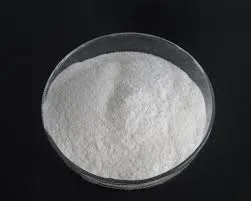
Nov . 28, 2024 04:26 Back to list
Hydroxyethyl Cellulose Applications in Paint Formulations and Coating Industry
The Role of Hydroxyethyl Cellulose in Paint Formulations
Hydroxyethyl cellulose (HEC) is a versatile, non-ionic cellulose ether used widely in various industries, particularly in the formulation of paints. Its unique properties make it an essential component in achieving desirable characteristics in paints and coatings, enhancing their performance and end-user experience. This article explores the functionalities, benefits, and applications of hydroxyethyl cellulose in paint formulations.
What is Hydroxyethyl Cellulose?
Hydroxyethyl cellulose is a water-soluble polymer derived from cellulose, which is obtained from plant fibers. The chemical modification involves the substitution of some hydroxyl groups in cellulose with hydroxyethyl groups, resulting in a product that is soluble in cold water and compatible with various solvents. HEC is known for its thickening, stabilizing, and film-forming properties, making it a valuable additive in paint formulations.
The Functionality of HEC in Paints
HEC serves several critical functions in paint formulations
1. Thickening Agent One of the primary roles of HEC in paints is to increase viscosity. The thickening effect aids in achieving the right consistency for application, preventing drippage and ensuring that the paint adheres well to surfaces. This is particularly crucial for wall paints where controlled flow and application are desired.
2. Stabilization HEC helps to stabilize paint formulations, enhancing shelf life by preventing the separation of components over time. Its capacity to create a stable colloidal suspension is essential when dealing with pigments and additives, ensuring uniform color distribution and performance.
3. Film-Forming Ability When paint dries, HEC contributes to the formation of a uniform film, enhancing the durability and appearance of the surface. The film formed by HEC can also provide additional attributes like water resistance and flexibility, which are important in various applications.
4. Improved Workability HEC enhances the workability of paint during application. It provides a smooth and even spread, allowing for better control and ease of use for painters. This improved application characteristic can significantly impact the quality of the finish.
Benefits of Using Hydroxyethyl Cellulose
The incorporation of hydroxyethyl cellulose in paint formulations brings multiple benefits
hydroxyethyl cellulose for paint

- Environmentally Friendly HEC is derived from natural cellulose, making it a more environmentally friendly option compared to synthetic thickeners
. Its use supports the trend towards green chemistry in paint production.- Enhanced Performance Paints with HEC exhibit improved performance metrics such as better adhesion, fewer defects, and greater resistance to sagging. This results in a higher quality product that meets consumer expectations.
- Wide Compatibility HEC is compatible with a variety of additives and pigments, making it suitable for many types of paint formulations, including latex and solvent-based paints.
- Cost-Effective Utilizing HEC can increase the efficiency of formulation processes and reduce the need for additional thickeners or stabilizers, leading to cost savings for manufacturers.
Applications of HEC in Paints
Hydroxyethyl cellulose is commonly used in several paint applications, including
- Architectural Coatings HEC is popular in latex paints and other architectural coatings for residential and commercial buildings. Its properties ensure that these paints are easy to apply and maintain their appearance over time.
- Industrial Coatings In industrial settings, HEC is used in coatings that require high durability and specific performance characteristics, such as automotive and machinery paints.
- Specialty Coatings HEC finds applications in specialty paints, including anti-corrosion and anti-fungal coatings, where its enhanced performance helps to meet specific regulatory requirements and consumer demands.
Conclusion
Hydroxyethyl cellulose is a vital ingredient in modern paint formulations. Its multifunctional properties help formulators create high-performance, user-friendly, and eco-friendly products that meet diverse market needs. As the paint industry continues to evolve toward sustainable practices, the importance of HEC in providing effective solutions will only grow. Whether for residential or industrial applications, HEC stands out as a key player in the world of coatings, ensuring that paintings not only look great but also perform exceptionally.
-
Versatile Hpmc Uses in Different Industries
NewsJun.19,2025
-
Redispersible Powder's Role in Enhancing Durability of Construction Products
NewsJun.19,2025
-
Hydroxyethyl Cellulose Applications Driving Green Industrial Processes
NewsJun.19,2025
-
Exploring Different Redispersible Polymer Powder
NewsJun.19,2025
-
Choosing the Right Mortar Bonding Agent
NewsJun.19,2025
-
Applications and Significance of China Hpmc in Modern Industries
NewsJun.19,2025







